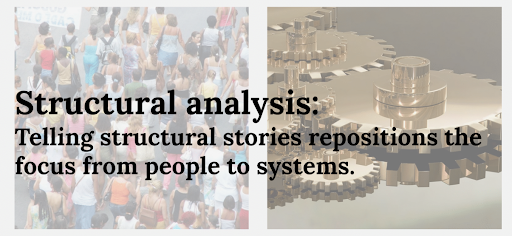Let’s Tell More Structural Stories
Structural stories focus on problems created by the systems we live in. Typically, Americans don’t see systems, but we always feel their impact.
For the past couple of weeks, I have been writing about how to talk about your work in today’s climate. This week, I want to talk about the power of telling structural stories that focus on problems created by the systems we live in. Generally, people don’t often see or understand systems, but we always feel their impact.
Structural Stories Point to the Real Source of Problems
Years ago, when I worked for Maryland Nonprofits, I had an early morning meeting in our Baltimore office. I was late getting out of the house and up to Baltimore, about an hour's drive. Halfway there, I realized that I left my lunch on the kitchen table. Ugh.
I thought no problem, I’ll just stop at the grocery store closest to the Baltimore office. At that time, there was only one, so I stopped there.
I run in and stop in my tracks. I look to the left and the right. There are no fresh vegetables, no grab-and-go meals, nothing I can make into a lunch. I realized it was like a bigger version of a Dollar Tree and not what I needed. Disappointed, I turn and walk out.
At that moment, I realized that grocery stores differ based on where you live.
In this scenario, it is tempting to overfocus on the people who shop at that store versus the foods that are easiest to access. I have had that same experience many times since then. Now, I recognize it more quickly. My everyday reality of being surrounded by grocery stores of every type is not every person’s reality. This is why we need structural stories.
Mainstream Media Rarely Tell Accurate Strutural Stories
I was doing some client work when I ran across a paper by the Collaborative on Media & Messaging that noted,
…[the] political attention to and media discussion of structural racism explicitly rose dramatically in the summer of 2020 due to the combination of COVID-19 disparities and George Floyd’s murder making the topic salient, the subsequent four years [was not sustained]. In fact, we uncover evidence not only that the discussion of structural racism has declined but also that there is rising attention to strategic counternarratives to bolster anti-equity initiatives in the forms of both the anti-critical race theory and anti-diversity equity and inclusion (DEI) discussion.
This was a huge AHA moment for me. There are fewer stories in mainstream media that feature a structural analysis of racism. Even fewer feature race and class together. It’s not my imagination. This study explains why it feels like racism is always framed around reverse racism.
Literally, I’ll read or watch something and instantly think: What in the ahistorical world did I just read. Or, I’ll ask, “What about whiteness???”
This disparity in storytelling makes telling structural stories even more important. Remember, the power of structural stories is that they focus on the system versus the person.
To do: In your writing this week, look for places where you can tell a structural story.
How we talk about systems matters. How our writing hides privilege also matters. Let’s talk about the race and class differences that public policy has created and maintains. Let's tell more structural stories.
Here are 3 things you can do right now:
Emphasize the system's failures, not the people's challenges.
Share stories of differential treatment within systems.
Always link to solutions that have the power to transform.
To learn more:
Click here for an example of the power of structural storytelling.
To take an action:
If you do not know how to create a structural story about about why racial equity matters, check out the Build your Your Equity Why: A 4-Step Guide.
You can search the Race in the Workplace blog archive by topic






